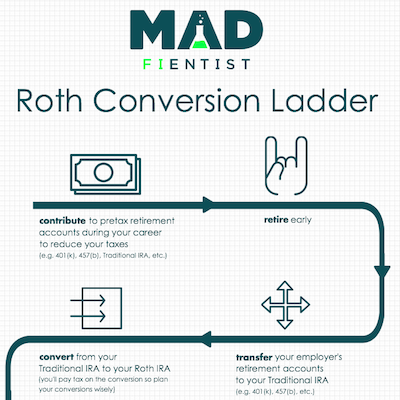How to Stack Tax Benefits for Even More Savings
A Mad Fientist reader shares how he utilizes tax-advantaged accounts to unlock even more cost-saving benefits! Read more → The post How to Stack Tax Benefits for Even More Savings appeared first on Mad Fientist.

A Mad Fientist reader named Brian reached out to me and said that he increased his savings rate by utilizing some of the tax-avoidance strategies I write about here.
Not only did these strategies help him to save more, they also allowed him to take advantage of other tax benefits that he hadn’t previously been eligible for (which then reduced his costs even more)!
He asked if I’d be interested in a case study (with his actual numbers) and I said yes!
Take it away, Brian…
If you’re frugal and willing to learn a little bit about the nuances in the tax code, you can save a massive percentage of your earnings every year.
This can be done by stacking the benefits of tax-advantaged savings.
By maximizing tax-deferred accounts first, a moderate income earner drives down their adjusted gross income (AGI). This in turn, may drastically reduce or even eliminate some of their largest yearly expenses.
How to Reduce Your Adjusted Gross Income (AGI)
Reduce your AGI by contributing to the following accounts:
- Traditional 401k
- Traditional IRA
- Health Savings Account (HSA)
Benefits of a Lower AGI
Lowering your AGI opens the possibility for:
- Becoming eligible for premium tax credits for health insurance
- Reducing or eliminating student loan payments
- Claiming additional tax credits (retirement savings credit, etc.)
- Receiving stimulus payments or other one-time benefits
My Numbers
Here is the strategy I’ve implemented for the past few years…
My total income was $58,070 for tax year 2020.
After contributing the maximum of $19,500 to my Traditional 401K and $6,000 to my Traditional IRA, my AGI was lowered to $32,570.
Now, here’s the interesting part. I purchased my health insurance through the ACA marketplace*. I’m fortunate to have good health, so I always select a high deductible health plan (HDHP) that is HSA compatible. I then maximized the HSA contribution ($3,550 for tax year 2020). This resulted in a health plan with a monthly premium of about $54 after the ACA Tax Credit (thanks to my lower AGI).
I’ve done this for the past few years and it’s been a great way to obtain low-cost health insurance while building up what the Mad Fientist calls the Ultimate Retirement Account.
Another bonus to accessing an HSA is that you can use it to lower your AGI even further. My already significantly-lowered AGI of $32,500 then became $29,020, which allowed me to claim the Retirement Savings Contributions Credit** for $200 (which in turn lowered my final tax liability).
The end result was a federal tax bill of about $1,607. Not bad!
Additionally, I live in a state where most of my income would fall in the 9% tax rate, so reducing state tax liability is another perk to consider when reducing your AGI. That being said, I’ve excluded state taxes for the sake of simplicity.
Here is an annual breakdown of my numbers compared to a lower savings rate of 5%:
| Low Saver | High Saver | |
|---|---|---|
| Income | $58,070 | $58,070 |
| 401k Contribution | $2,904 | $19,500 |
| Traditional IRA | $0 | $6,000 |
| HSA | $0 | $3,550 |
| AGI | $55,166 | $29,020 |
And here are my annual costs:
| Low Saver | High Saver | |
|---|---|---|
| Health Plan | $5,408 | $648 |
| FICA Taxes | $4,365 | $4,365 |
| Federal Taxes | $4,944 | $1,607 |
| Cost Savings | $8,097 |
New Tax Changes – ARPA
Due to the American Rescue Plan Act (ARPA passed in March 2021), participants in the ACA marketplace receive additional subsidies on the same level of income for 2021 and 2022.
Also, higher income earners may now qualify for a subsidy. This opens the door to qualify for low- or no-cost health insurance even with a slighter higher AGI. I’m currently exploring the option of keeping my monthly premium the same, while converting some of my traditional IRA to a Roth IRA, which would not have been possible prior to the ARPA.
AGI and Student Loan Payments
For those with federal student loans, reducing your AGI can also significantly reduce or eliminate student loan payments, depending on your repayment plan.
I was fortunate to graduate with a very modest amount of debt, so I was able to pay the balance off in a couple of years. However, I’ve known others with large debts relative to their income that used this strategy to bring their monthly student loan payments down to $0 while building up healthy retirement accounts. Some have even combined this with Public Service Loan Forgiveness to wipe out their loans completely after 10 years!
Conclusion
In summary, it is possible to save a massive amount for retirement while minimizing or eliminating other expenses. I encourage your readers to explore how they can stack the benefits available to them in order to save more for retirement while living a great life during their working years.
I look forward to any responses in the comments on other tax savvy ways to save.
Cheers!
* My employer only offers a low deductible health insurance plan, which normally would exclude me from taking part in the ACA marketplace. However, the premiums are higher than the minimum value standard which allows me to opt into an ACA plan.
** See Retirement Savings Contribution Credit qualification tables in the links below.
Resources
- Affordable Coverage definition for ACA
- Retirement Savings Contributions Credit qualification tables
- Here is a great subsidy calculator from the Kaiser Family Foundation. It’s been updated to reflect the most recent changes to ACA subsidies.
Related Post
The post How to Stack Tax Benefits for Even More Savings appeared first on Mad Fientist.






























.png)





















![‘Companion’ Ending Breakdown: Director Drew Hancock Tells All About the Film’s Showdown and Potential Sequel: ‘That’s the Future I Want for [Spoiler]’](https://variety.com/wp-content/uploads/2025/02/MCDCOMP_WB028.jpg?#)

























